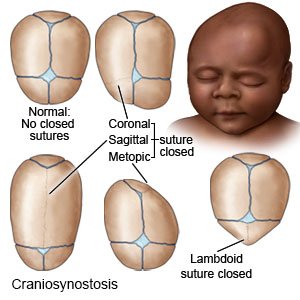Craniosynostosis
Medically reviewed by Drugs.com. Last updated on Aug 4, 2025.
AMBULATORY CARE:
Craniosynostosis
is a condition that causes one or more skull bones to close (fuse) too early. Tissues that connect skull bones are called sutures. Sutures usually close after a few years, when a baby's brain is finished growing. When only 1 suture closes too soon, the brain continues to grow to a normal size. When several areas close too soon, the brain cannot grow to its full size or completely develop. Your baby's sutures may have closed before or after he or she was born.
Types of craniosynostosis:
- Sagittal is the suture on top of your baby's head. When it closes too early, the head grows long and narrow. This is the most common type.
- Coronal are sutures are on the left and right of your baby's skull. They go from each ear up to the sagittal suture at the top of the skull. When one closes too early, the forehead may be flat on that side. The eye area may be higher on that side. The nose may also be pulled to that side. If both of the sutures close too early, the head grows wide and short.
- Lambdoid is the suture that runs along the back of your baby's head. When it closes too early, the back of the head is flat.
- Metopic is the suture that goes from your baby's nose to the suture at the top of his or her head. When it closes too early, the top of the head grows into a triangle. It is narrow in the front and wide in the back. This is the rarest type.
 |
Other signs your baby may have,
depending on the type of craniosynostosis, the sutures involved, and when they closed:
- No soft spots on your baby's head
- Slow head growth, or a lack of head growth
- A hard ridge where the sutures closed
- Misshaped arms, legs, hands, feet, or torso (if caused by certain genetic conditions)
- Delays in development, seizures, headaches, or blindness (if not treated)
Call your baby's doctor if:
- You have questions or concerns about your baby's condition or care.
Treatment
may not be needed if craniosynostosis is mild. The following are the most common treatments used, if needed:
- A helmet may be fitted to your baby's head. The helmet helps change the shape of the skull so the brain has room to grow. The helmet also helps the way the head looks. A helmet may be used if the condition is mild.
- Surgery may be used to help make the head shape more even. It may also give the brain room to grow and help take pressure off the brain and nerves. Healthcare providers will explain benefits and risks of this surgery. This may help you feel good about the decision you make.
Care for your child:
- Help your child develop healthy self-esteem as he or she gets older. Your child may feel self-conscious or have body image problems if he or she looks different from other children. Try not to minimize your child's feelings. Listen when your child wants to talk about how he or she looks. Also talk with your child about his or her strengths and interests. For example, your child may be a talented artist or writer, or have a great sense of humor. He or she may enjoy working with computers or be good at math. By helping your child focus on strengths and interests, you can help make appearance less important.
- Ask about early intervention programs, if needed. Early intervention includes therapy, exercises, and activities that will help with development during the first 3 years. Your child may be taught physical, speech, or social skills. He or she may work with more than one provider to learn new skills. Providers can work with you and everyone who takes care of your child. This will help make sure everyone knows how to support your child.
- Join a support group. It may help to talk with other parents who have a child with craniosynostosis.
Follow up with your baby's healthcare providers as directed:
Your baby may need ongoing tests to check his or her brain and skull development. Your baby's head size will be measured at each visit. Fast growth may be a sign of extra fluid in the brain that must be treated. Write down your questions so you remember to ask them during your visits.
© Copyright Merative 2025 Information is for End User's use only and may not be sold, redistributed or otherwise used for commercial purposes.
The above information is an educational aid only. It is not intended as medical advice for individual conditions or treatments. Talk to your doctor, nurse or pharmacist before following any medical regimen to see if it is safe and effective for you.
Further information
Always consult your healthcare provider to ensure the information displayed on this page applies to your personal circumstances.
